高考英语语法之非谓语动词
图片预览
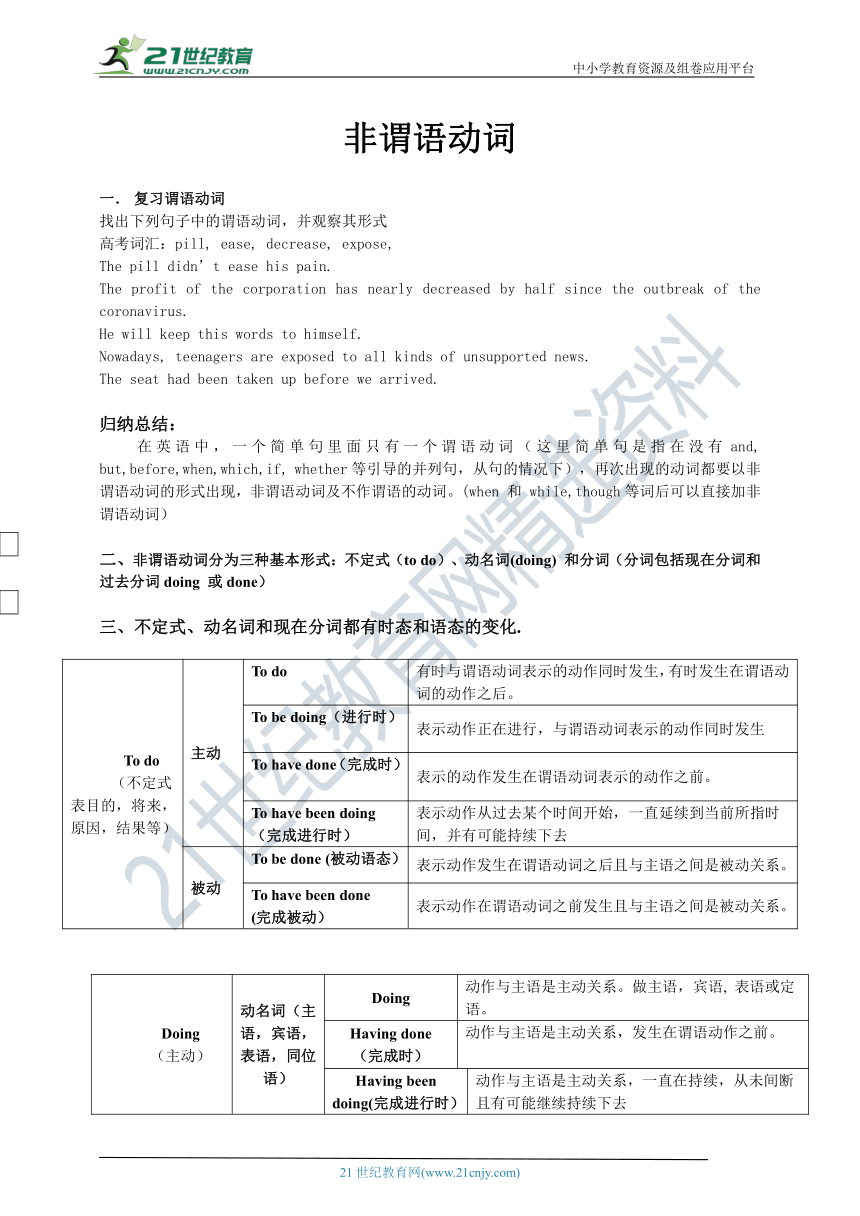
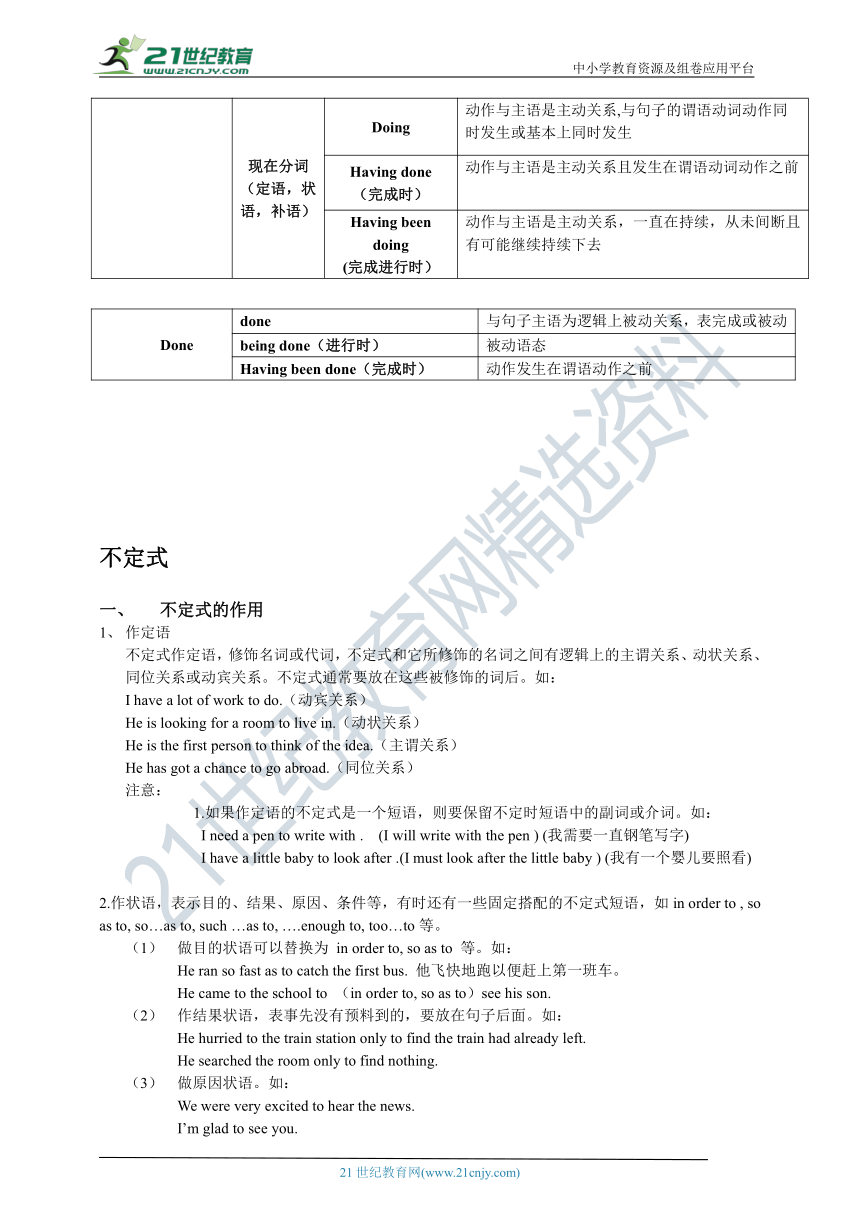
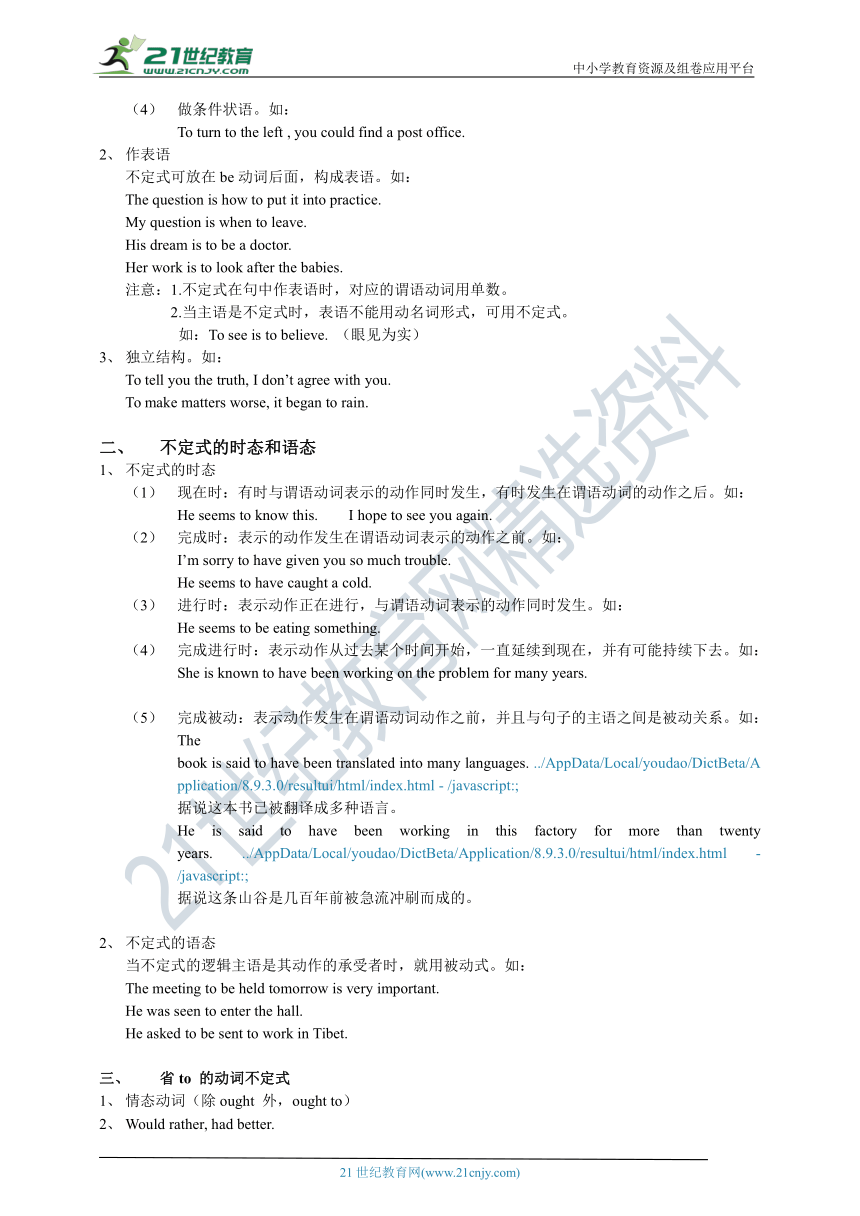
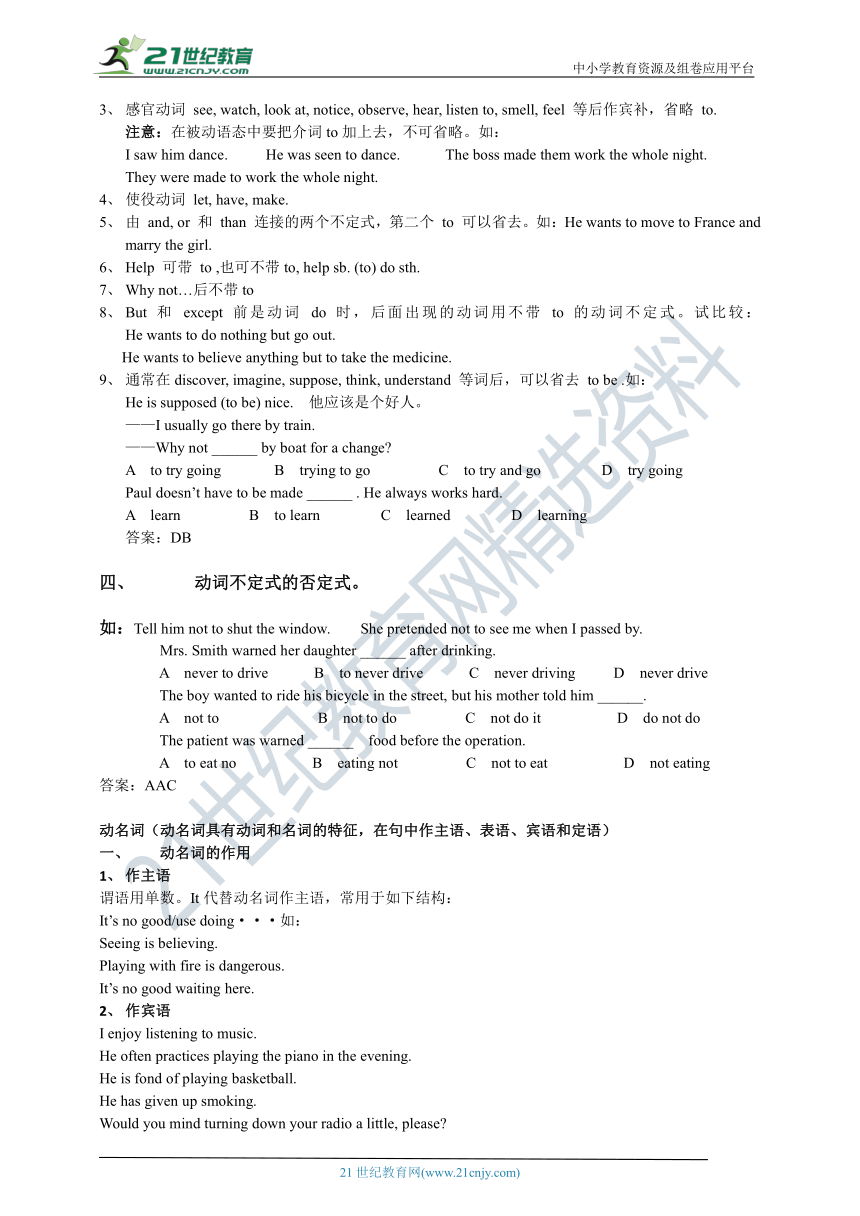
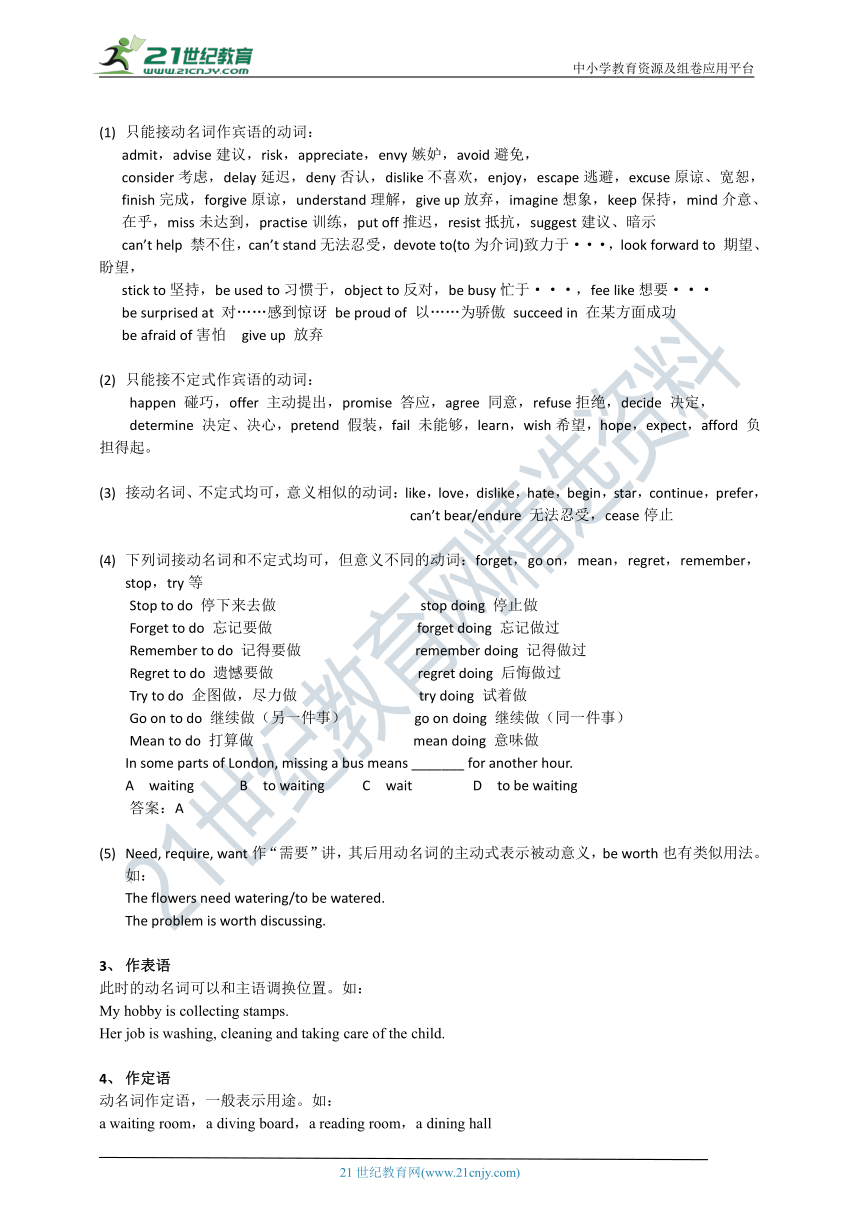
文档简介
中小学教育资源及组卷应用平台
非谓语动词
1.
复习谓语动词
找出下列句子中的谓语动词,并观察其形式
高考词汇:pill,
ease,
decrease,
expose,
The
pill
didn’t
ease
his
pain.
The
profit
of
the
corporation
has
nearly
decreased
by
half
since
the
outbreak
of
the
coronavirus.
He
will
keep
this
words
to
himself.
Nowadays,
teenagers
are
exposed
to
all
kinds
of
unsupported
news.
The
seat
had
been
taken
up
before
we
arrived.
归纳总结:
在英语中,一个简单句里面只有一个谓语动词(这里简单句是指在没有and,
but,before,when,which,if,
whether等引导的并列句,从句的情况下),再次出现的动词都要以非谓语动词的形式出现,非谓语动词及不作谓语的动词。(when
和
while,though等词后可以直接加非谓语动词)
二、非谓语动词分为三种基本形式:不定式(to
do)、动名词(doing)
和分词(分词包括现在分词和过去分词doing
或done)
三、不定式、动名词和现在分词都有时态和语态的变化.
To
do(不定式表目的,将来,原因,结果等)
主动
To
do
有时与谓语动词表示的动作同时发生,有时发生在谓语动词的动作之后。
To
be
doing(进行时)
表示动作正在进行,与谓语动词表示的动作同时发生
To
have
done(完成时)
表示的动作发生在谓语动词表示的动作之前。
To
have
been
doing(完成进行时)
表示动作从过去某个时间开始,一直延续到当前所指时间,并有可能持续下去
被动
To
be
done
(被动语态)
表示动作发生在谓语动词之后且与主语之间是被动关系。
To
have
been
done(完成被动)
表示动作在谓语动词之前发生且与主语之间是被动关系。
Doing(主动)
动名词(主语,宾语,表语,同位语)
Doing
动作与主语是主动关系。做主语,宾语,
表语或定语。
Having
done(完成时)
动作与主语是主动关系,发生在谓语动作之前。
Having
been
doing(完成进行时)
动作与主语是主动关系,一直在持续,从未间断且有可能继续持续下去
现在分词(定语,状语,补语)
Doing
动作与主语是主动关系,与句子的谓语动词动作同时发生或基本上同时发生
Having
done(完成时)
动作与主语是主动关系且发生在谓语动词动作之前
Having
been
doing(完成进行时)
动作与主语是主动关系,一直在持续,从未间断且有可能继续持续下去
Done
done
与句子主语为逻辑上被动关系,表完成或被动
being
done(进行时)
被动语态
Having
been
done(完成时)
动作发生在谓语动作之前
不定式
1、
不定式的作用
1、
作定语
不定式作定语,修饰名词或代词,不定式和它所修饰的名词之间有逻辑上的主谓关系、动状关系、同位关系或动宾关系。不定式通常要放在这些被修饰的词后。如:
I
have
a
lot
of
work
to
do.(动宾关系)
He
is
looking
for
a
room
to
live
in.(动状关系)
He
is
the
first
person
to
think
of
the
idea.(主谓关系)
He
has
got
a
chance
to
go
abroad.(同位关系)
注意:
1.如果作定语的不定式是一个短语,则要保留不定时短语中的副词或介词。如:
I
need
a
pen
to
write
with
.
(I
will
write
with
the
pen
)
(我需要一直钢笔写字)
I
have
a
little
baby
to
look
after
.(I
must
look
after
the
little
baby
)
(我有一个婴儿要照看)
2.作状语,表示目的、结果、原因、条件等,有时还有一些固定搭配的不定式短语,如in
order
to
,
so
as
to,
so…as
to,
such
…as
to,
….enough
to,
too…to等。
(1)
做目的状语可以替换为
in
order
to,
so
as
to
等。如:
He
ran
so
fast
as
to
catch
the
first
bus.
他飞快地跑以便赶上第一班车。
He
came
to
the
school
to
(in
order
to,
so
as
to)see
his
son.
(2)
作结果状语,表事先没有预料到的,要放在句子后面。如:
He
hurried
to
the
train
station
only
to
find
the
train
had
already
left.
He
searched
the
room
only
to
find
nothing.
(3)
做原因状语。如:
We
were
very
excited
to
hear
the
news.
I’m
glad
to
see
you.
(4)
做条件状语。如:
To
turn
to
the
left
,
you
could
find
a
post
office.
2、
作表语
不定式可放在be动词后面,构成表语。如:
The
question
is
how
to
put
it
into
practice.
My
question
is
when
to
leave.
His
dream
is
to
be
a
doctor.
Her
work
is
to
look
after
the
babies.
注意:1.不定式在句中作表语时,对应的谓语动词用单数。
2.当主语是不定式时,表语不能用动名词形式,可用不定式。
如:To
see
is
to
believe.
(眼见为实)
3、
独立结构。如:
To
tell
you
the
truth,
I
don’t
agree
with
you.
To
make
matters
worse,
it
began
to
rain.
2、
不定式的时态和语态
1、
不定式的时态
(1)
现在时:有时与谓语动词表示的动作同时发生,有时发生在谓语动词的动作之后。如:
He
seems
to
know
this.
I
hope
to
see
you
again.
(2)
完成时:表示的动作发生在谓语动词表示的动作之前。如:
I’m
sorry
to
have
given
you
so
much
trouble.
He
seems
to
have
caught
a
cold.
(3)
进行时:表示动作正在进行,与谓语动词表示的动作同时发生。如:
He
seems
to
be
eating
something.
(4)
完成进行时:表示动作从过去某个时间开始,一直延续到现在,并有可能持续下去。如:
She
is
known
to
have
been
working
on
the
problem
for
many
years.
(5)
完成被动:表示动作发生在谓语动词动作之前,并且与句子的主语之间是被动关系。如:
The
book?is?said?to?have?been?translated?into?many?languages.?../AppData/Local/youdao/DictBeta/Application/8.9.3.0/resultui/html/index.html
-
/javascript:;
(?..?/?AppData?/?Local?/?youdao?/?DictBeta?/?Application?/?8.9.3.0?/?resultui?/?html?/?index.html"
\l
"?/?javascript:;"
\o
"真人发音?)
据说这本书已被翻译成多种语言。
He?is?said?to?have?been?working
in?this?factory
for
more?than?twenty
years.?../AppData/Local/youdao/DictBeta/Application/8.9.3.0/resultui/html/index.html
-
/javascript:;
(?..?/?AppData?/?Local?/?youdao?/?DictBeta?/?Application?/?8.9.3.0?/?resultui?/?html?/?index.html"
\l
"?/?javascript:;"
\o
"真人发音?)
据说这条山谷是几百年前被急流冲刷而成的。
2、
不定式的语态
当不定式的逻辑主语是其动作的承受者时,就用被动式。如:
The
meeting
to
be
held
tomorrow
is
very
important.
He
was
seen
to
enter
the
hall.
He
asked
to
be
sent
to
work
in
Tibet.
3、
省to
的动词不定式
1、
情态动词(除ought
外,ought
to)
2、
Would
rather,
had
better.
3、
感官动词
see,
watch,
look
at,
notice,
observe,
hear,
listen
to,
smell,
feel
等后作宾补,省略
to.
注意:在被动语态中要把介词to加上去,不可省略。如:
I
saw
him
dance.
He
was
seen
to
dance.
The
boss
made
them
work
the
whole
night.
They
were
made
to
work
the
whole
night.
4、
使役动词
let,
have,
make.
5、
由
and,
or
和
than
连接的两个不定式,第二个
to
可以省去。如:He
wants
to
move
to
France
and
marry
the
girl.
6、
Help
可带
to
,也可不带to,
help
sb.
(to)
do
sth.
7、
Why
not…后不带to
8、
But
和
except
前是动词
do
时,后面出现的动词用不带
to
的动词不定式。试比较:
He
wants
to
do
nothing
but
go
out.
He
wants
to
believe
anything
but
to
take
the
medicine.
9、
通常在discover,
imagine,
suppose,
think,
understand
等词后,可以省去
to
be
.如:
He
is
supposed
(to
be)
nice.
他应该是个好人。
——I
usually
go
there
by
train.
——Why
not
______
by
boat
for
a
change?
A
to
try
going
B
trying
to
go
C
to
try
and
go
D
try
going
Paul
doesn’t
have
to
be
made
______
.
He
always
works
hard.
A
learn
B
to
learn
C
learned
D
learning
答案:DB
4、
动词不定式的否定式。
如:Tell
him
not
to
shut
the
window.
She
pretended
not
to
see
me
when
I
passed
by.
Mrs.
Smith
warned
her
daughter
______
after
drinking.
A
never
to
drive
B
to
never
drive
C
never
driving
D
never
drive
The
boy
wanted
to
ride
his
bicycle
in
the
street,
but
his
mother
told
him
______.
A
not
to
B
not
to
do
C
not
do
it
D
do
not
do
The
patient
was
warned
______
food
before
the
operation.
A
to
eat
no
B
eating
not
C
not
to
eat
D
not
eating
答案:AAC
动名词(动名词具有动词和名词的特征,在句中作主语、表语、宾语和定语)
1、
动名词的作用
1、
作主语
谓语用单数。It代替动名词作主语,常用于如下结构:
It’s
no
good/use
doing···如:
Seeing
is
believing.
Playing
with
fire
is
dangerous.
It’s
no
good
waiting
here.
2、
作宾语
I
enjoy
listening
to
music.
He
often
practices
playing
the
piano
in
the
evening.
He
is
fond
of
playing
basketball.
He
has
given
up
smoking.
Would
you
mind
turning
down
your
radio
a
little,
please?
(1)
只能接动名词作宾语的动词:
admit,advise建议,risk,appreciate,envy嫉妒,avoid避免,
consider考虑,delay延迟,deny否认,dislike不喜欢,enjoy,escape逃避,excuse原谅、宽恕,
finish完成,forgive原谅,understand理解,give
up放弃,imagine想象,keep保持,mind介意、在乎,miss未达到,practise训练,put
off推迟,resist抵抗,suggest建议、暗示
can’t
help
禁不住,can’t
stand无法忍受,devote
to(to为介词)致力于···,look
forward
to
期望、盼望,
stick
to坚持,be
used
to习惯于,object
to反对,be
busy忙于···,fee
like想要···
be
surprised
at
对……感到惊讶
be
proud
of
以……为骄傲
succeed
in
在某方面成功
be
afraid
of害怕
give
up
放弃
(2)
只能接不定式作宾语的动词:
happen
碰巧,offer
主动提出,promise
答应,agree
同意,refuse拒绝,decide
决定,
determine
决定、决心,pretend
假装,fail
未能够,learn,wish希望,hope,expect,afford
负担得起。
(3)
接动名词、不定式均可,意义相似的动词:like,love,dislike,hate,begin,star,continue,prefer,
can’t
bear/endure
无法忍受,cease停止
(4)
下列词接动名词和不定式均可,但意义不同的动词:forget,go
on,mean,regret,remember,stop,try等
Stop
to
do
停下来去做
stop
doing
停止做
Forget
to
do
忘记要做
forget
doing
忘记做过
Remember
to
do
记得要做
remember
doing
记得做过
Regret
to
do
遗憾要做
regret
doing
后悔做过
Try
to
do
企图做,尽力做
try
doing
试着做
Go
on
to
do
继续做(另一件事)
go
on
doing
继续做(同一件事)
Mean
to
do
打算做
mean
doing
意味做
In
some
parts
of
London,
missing
a
bus
means
_______
for
another
hour.
A
waiting
B
to
waiting
C
wait
D
to
be
waiting
答案:A
(5)
Need,
require,
want作“需要”讲,其后用动名词的主动式表示被动意义,be
worth也有类似用法。如:
The
flowers
need
watering/to
be
watered.
The
problem
is
worth
discussing.
3、
作表语
此时的动名词可以和主语调换位置。如:
My
hobby
is
collecting
stamps.
Her
job
is
washing,
cleaning
and
taking
care
of
the
child.
4、
作定语
动名词作定语,一般表示用途。如:
a
waiting
room,a
diving
board,a
reading
room,a
dining
hall
there
are
a
lot
of
swimming
pools
in
the
city.
a
swimming
pool
=
a
pool
for
swimming
2、
动名词的时态
动名词的动作发生在谓语动词所表示的动作之前,通常要用完成式,否则都用一般式。如:
We
are
interested
in
playing
chess.
He
was
praised
for
having
finished
the
work
ahead
of
time.
I’m
sorry
for
not
having
kept
my
promise.
分词(分词分为现在分词doing和过去分词done。在句中作定语、状语、表语和宾语补足语。)
现在分词和过去分词的区别:
在语态上,现在分词表示主动意义,过去分词表示被动意义;
在时间上,现在分词表示的动作往往正在进行或者与谓语动词同时发生,过去分词表示的动作已经完成或没有一定的时间性。
如:falling
leaves
正在下落的树叶
fallen
leaves
已经落在地上的树叶
1、
分词的作用
1、
作定语
(1)
单个分词作定语,分词前置。如:
The
sleeping
boy
is
my
son.
The
excited
people
rushed
into
the
building.
A
lost
opportunity
never
returns.
He
is
a
retired
worker.
注:(1)现在分词作定语表动作,它与所修饰的名词之间存在逻辑上的主谓关系,可改写成一个定语从句。
如果为单词,放在被修饰n之前,为短语,放在被修饰n之后。
如:a
sleeping
boy
=a
boy
who
is
sleeping
a
developing
country
=a
country
which
is
developing
(2)动名词作定语通常表示它所修饰的名词的用途或性质,可改写成一个for的短语,两者不存在逻辑上的主谓关系。
如:a
washing
machine
=
a
machine
for
washing
a
waiting
room=
a
room
for
waiting
(2)
分词短语作定语,分词后置;分词修饰不定代词something等要后置;个别分词如give,left等作定语也后置。如:
The
girl
standing
under
the
tree
is
my
niece.
The
building
built
last
year
is
our
library.
This
is
the
question
given.
There
is
nothing
interesting.
(3)
过去分词作定语与其修饰的词是被动关系,相当于一个被动语态的定语从句。如:
Most
of
the
people
invited
to
the
party
were
famous
scientists.=
Most
of
the
people
who/that
was
invited
to
the
party
were
famous
scientists
The
first
textbook
______
for
teaching
English
as
a
foreign
language
came
out
in
the
16th
century.
A
have
written
B
to
be
written
C
being
written
D
written
What’s
the
language
______
in
Germany?
A
speaking
B
spoken
C
be
spoken
D
to
speak
Prices
of
daily
goods
______
through
a
computer
can
be
lower
than
store
prices.
A
are
bought
B
bought
C
been
bought
D
buying.
When
I
got
back
home
I
saw
a
message
pinned
to
the
door
______
“Sorry
to
miss
you;
will
call
later.”
A
read
B
reads
C
to
read
D
reading
解析:reading
与
pinned
to
the
door
一样作message
的后置定语,相当于which
read和which
is
pinned。
pinned和
reading的逻辑主语都是
message,它与pin是被动关系,用—ed
形式,与
read
是主动关系,用—ing
形式
答案:D
BBD
2、
作状语
现在分词和过去分词在句中可以作时间、原因、方式、伴随、条件、结果等状语。
Not
receiving
any
letter
from
him,
I
gave
him
a
call.=As
I
didn’t
receive
any
letter
from
him,
I
gave
him
a
call.(
)
Given
more
attention,
the
trees
could
have
grown
better.=If
more
attention
was
given,
the
trees
could
have
grown
better.(
)
Walking
along
the
street,
I
ran
across
my
old
friend.
Bitten
by
a
snake,
he
was
taken
to
hospital(
).
Though
defeated,
he
didn’t
lose
heart.(
)
He
lay
on
the
grass,
looking
into
the
sky.(
)
He
came
running
to
tell
me
the
good
news.(
)
______
some
officials,
Napoleon
inspected
his
army.
A
Followed
B
Followed
by
C
Being
followed
D
Having
been
followed
There
was
a
terrible
noise______
the
sudden
burst
of
light.
A
followed
B
following
C
to
be
followed
D
being
followed
______
,
liquids
can
be
changed
into
gases.
A
Heating
B
To
be
heated
C
Heated
D
Heat
答案:BBC
注意:
选择现在分词还是过去分词,关键看主句的主语。如分词的动作是由主句的主语发出,分词就用现在分词,反之就用过去分词。试比较:
(Being)Used
for
a
long
time,
the
book
looks
old.由于用了很长时间,这本书看上去很旧。
Using
the
book,
I
find
it
useful.在使用的过程中,我发现这本书很有用。
3、分词作状语时,其逻辑主语必须和主句的主语一致,如果不一致,就用独立主格结构,即在分词前加上它的逻辑主语。现在分词的完成式主要用于作状语,一般不用作定语。
例:The
test
finished(=When
the
test
was
finished),
we
began
our
holiday.
The
president
assassinated(=Because
the
president
was
assassinated),
the
whole
country
was
in
deep
sorrow.
Weather
permitting(=
If
weather
permits),
we
are
going
to
visit
you
tomorrow.
归纳:
★
独立主格结构的特点:①
独立主格结构的逻辑主语与句子,它独立存在。②独立主格结构中做逻辑主语的名词或代词与后面的分词或不定式是逻辑上的主动或被动关系。③独立主格结构一般有逗号和主句分开
★
独立主格结构的构成:①名词/代词+分词;②名词/代词+不定式;③with/without+名词/代词+分词/不定式。
4、
作表语
现在分词作表语多表示主语具有的特征,过去分词作表语多指主语所处的状态。如:
The
film
is
touching.
The
glass
is
broken.
She
looked
tired
with
cooking.
He
remained
standing
beside
the
table.
—I’m
very______
with
my
own
cooking.
It
looks
nice
and
smells
delicious.
—Mm,
it
does
have
a
______
smell.
A
pleasant;
pleased
B
pleased;
pleased
C
pleasant;
pleasant
D
pleased;
pleasant
答案:D
5、
作宾语补足语
分词和不定式一样,在一些感官动词或使役动词后作宾语补足语。如:
I
smell
something
burning.
I
heard
him
singing
the
song.
I
heard
my
name
called.
I
can’t
make
myself
understood
in
English.
I
found
my
car
missing.
I’ll
have
my
watch
repaired.我想把我的手表修一下。
The
managers
discussed
the
plan
that
they
would
like
to
see
______
the
next
year.
A
carry
out
B
carrying
out
C
carried
out
D
to
carry
out
答案:C
6、
作插入语
其结构是固定的,意思上的主语并不是句子的主语。
generally
speaking
一般说来
talking
of
(speaking
of)
说到
strictly
speaking
严格地说
judging
from
从···判断
all
things
considered
从整体来看
taking
all
things
into
consideration
全面看来。如:
Judging
from
his
face,
he
must
be
ill.从他的脸色看,他一定是病了。
Generally
speaking,
dogs
can
run
faster
than
pigs.总的来说,狗比猪跑得快。
1、
现在分词的时态
1、
与主语动词同时。如:
Arriving
there,
they
found
the
boy
dead.刚一到那儿,他们就发现那男孩死了。
The
secretary
worked
late
into
the
night,
______
a
long
speech
for
the
president.
A
to
prepare
B
preparing
C
prepared
D
was
preparing
答案:B
2、
先于主语动词
分词作时间状语,如果先于主动词的动作,且强调先后,要用having
done。如:
Having
finished
his
homework,
he
went
out
for
a
walk.
After
he
had
finished
his
homework,
he
went
out
for
a
walk.
做完作业,他出去散步。
______
a
reply,
he
decided
to
write
again.
A
Not
receiving
B
Receiving
not
C
Not
having
received
D
Having
not
received
答案:C
2、
过去分词的时态
1、
一般时态,表示动作已经完成或仅仅表被动关系如:
She
is
the
girl
stopped
by/who
was
stopped
by
the
car.她就是那个被车拦住的女孩。
Those
developed
countries
play
major
roles
in
the
world
economy.
a
retired
person
一个退休的人
a
fallen
ball
一个落下来的球
a
burnt-out
match
烧完了的火柴
2、进行时态,表示被动和动作正在进行,翻译成“正在被……”
The
bridge
being
built
will
be
the
largest
one
in
this
country.
The
song
being
sung
is
very
popular
with
the
students.
3、
完成时态,表被动且先于谓语动词动作发生
Having
been
told
many
times,
he
still
repeated
the
same
mistakes.
Having
finished
his
homework,
he
rushed
out
to
play
basketball
with
his
friends.
区分主动与被动:
1.He
followed
his
students
and
came
in.
------
He
came
in,
____________
his
students.
2.He
came
in
and
was
followed
by
his
students
-----
He
came
in
,____________by
his
students.
3.
The
map
was
used
for
a
long
time.
It
looks
old.(用非谓语动改写并句子)
4.I
used
the
map
;
I
finally
found
the
remote
island.(用非谓语动词改写句子)
强化练习:
1、综合练习
1.
正在下落的叶子(fall)
2.
已经落在地上的叶子
(fall)
3.
睡着的男孩是我的儿子。(sleep)
4.
失去的机会绝不会再回来。(lose)
5.
发展中国家
发达国家
.
6.
This
is
the
question
(giving/
given)
7.
Most
of
the
students
(take
part
in
)
the
competition
were
his
classmates.
8.
There
is
only
some
beef
(leave)
in
the
bridge.
二、用非谓语动词合并句子:
1.
The
girl
lies
on
the
grass.
She
is
my
niece.
2.
The
building
was
build
last
year.
It
is
our
library.
3.
The
actress
was
guarded
by
three
strong
men.
She
appeared
at
the
airport.
4.
Tom
was
beaten
by
his
classmates.
He
cried;
He
went
back
home.
5.
He
was
humiliated
by
his
roommate.
He
went
out
of
the
dormitory.
He
felt
low
答案:
区分主动与被动:1.Following
2.
Followed
3.
Used
for
a
long
time,
the
map
looks
old.
4.
Using
the
map,
I
finally
found
the
remote
island.
强化练习:一、1.
the
falling
leaves
2.
the
fallen
leaves
3.
The
sleeping
boy
is
my
son.
4.The
lost
opportunities
will
never
come
back.
5.
Developing
countries/
Developed
countries
6.
given
8.
Left
二、1.
The
girl
lying
on
the
grass
is
my
niece.
2.
The
building
built
last
year
is
our
library.
3.
Guarded
by
three
strong
men.
The
actress
appeared
at
the
airport.
4.
Beaten
by
his
classmates,
Tom
went
back
home,
crying.
5.
Humiliated
by
his
roommate,
he
went
out
of
the
dormitory,
feeling
low.
21世纪教育网
www.21cnjy.com
精品试卷·第
2
页
(共
2
页)
HYPERLINK
"http://21世纪教育网(www.21cnjy.com)
"
21世纪教育网(www.21cnjy.com)
非谓语动词
1.
复习谓语动词
找出下列句子中的谓语动词,并观察其形式
高考词汇:pill,
ease,
decrease,
expose,
The
pill
didn’t
ease
his
pain.
The
profit
of
the
corporation
has
nearly
decreased
by
half
since
the
outbreak
of
the
coronavirus.
He
will
keep
this
words
to
himself.
Nowadays,
teenagers
are
exposed
to
all
kinds
of
unsupported
news.
The
seat
had
been
taken
up
before
we
arrived.
归纳总结:
在英语中,一个简单句里面只有一个谓语动词(这里简单句是指在没有and,
but,before,when,which,if,
whether等引导的并列句,从句的情况下),再次出现的动词都要以非谓语动词的形式出现,非谓语动词及不作谓语的动词。(when
和
while,though等词后可以直接加非谓语动词)
二、非谓语动词分为三种基本形式:不定式(to
do)、动名词(doing)
和分词(分词包括现在分词和过去分词doing
或done)
三、不定式、动名词和现在分词都有时态和语态的变化.
To
do(不定式表目的,将来,原因,结果等)
主动
To
do
有时与谓语动词表示的动作同时发生,有时发生在谓语动词的动作之后。
To
be
doing(进行时)
表示动作正在进行,与谓语动词表示的动作同时发生
To
have
done(完成时)
表示的动作发生在谓语动词表示的动作之前。
To
have
been
doing(完成进行时)
表示动作从过去某个时间开始,一直延续到当前所指时间,并有可能持续下去
被动
To
be
done
(被动语态)
表示动作发生在谓语动词之后且与主语之间是被动关系。
To
have
been
done(完成被动)
表示动作在谓语动词之前发生且与主语之间是被动关系。
Doing(主动)
动名词(主语,宾语,表语,同位语)
Doing
动作与主语是主动关系。做主语,宾语,
表语或定语。
Having
done(完成时)
动作与主语是主动关系,发生在谓语动作之前。
Having
been
doing(完成进行时)
动作与主语是主动关系,一直在持续,从未间断且有可能继续持续下去
现在分词(定语,状语,补语)
Doing
动作与主语是主动关系,与句子的谓语动词动作同时发生或基本上同时发生
Having
done(完成时)
动作与主语是主动关系且发生在谓语动词动作之前
Having
been
doing(完成进行时)
动作与主语是主动关系,一直在持续,从未间断且有可能继续持续下去
Done
done
与句子主语为逻辑上被动关系,表完成或被动
being
done(进行时)
被动语态
Having
been
done(完成时)
动作发生在谓语动作之前
不定式
1、
不定式的作用
1、
作定语
不定式作定语,修饰名词或代词,不定式和它所修饰的名词之间有逻辑上的主谓关系、动状关系、同位关系或动宾关系。不定式通常要放在这些被修饰的词后。如:
I
have
a
lot
of
work
to
do.(动宾关系)
He
is
looking
for
a
room
to
live
in.(动状关系)
He
is
the
first
person
to
think
of
the
idea.(主谓关系)
He
has
got
a
chance
to
go
abroad.(同位关系)
注意:
1.如果作定语的不定式是一个短语,则要保留不定时短语中的副词或介词。如:
I
need
a
pen
to
write
with
.
(I
will
write
with
the
pen
)
(我需要一直钢笔写字)
I
have
a
little
baby
to
look
after
.(I
must
look
after
the
little
baby
)
(我有一个婴儿要照看)
2.作状语,表示目的、结果、原因、条件等,有时还有一些固定搭配的不定式短语,如in
order
to
,
so
as
to,
so…as
to,
such
…as
to,
….enough
to,
too…to等。
(1)
做目的状语可以替换为
in
order
to,
so
as
to
等。如:
He
ran
so
fast
as
to
catch
the
first
bus.
他飞快地跑以便赶上第一班车。
He
came
to
the
school
to
(in
order
to,
so
as
to)see
his
son.
(2)
作结果状语,表事先没有预料到的,要放在句子后面。如:
He
hurried
to
the
train
station
only
to
find
the
train
had
already
left.
He
searched
the
room
only
to
find
nothing.
(3)
做原因状语。如:
We
were
very
excited
to
hear
the
news.
I’m
glad
to
see
you.
(4)
做条件状语。如:
To
turn
to
the
left
,
you
could
find
a
post
office.
2、
作表语
不定式可放在be动词后面,构成表语。如:
The
question
is
how
to
put
it
into
practice.
My
question
is
when
to
leave.
His
dream
is
to
be
a
doctor.
Her
work
is
to
look
after
the
babies.
注意:1.不定式在句中作表语时,对应的谓语动词用单数。
2.当主语是不定式时,表语不能用动名词形式,可用不定式。
如:To
see
is
to
believe.
(眼见为实)
3、
独立结构。如:
To
tell
you
the
truth,
I
don’t
agree
with
you.
To
make
matters
worse,
it
began
to
rain.
2、
不定式的时态和语态
1、
不定式的时态
(1)
现在时:有时与谓语动词表示的动作同时发生,有时发生在谓语动词的动作之后。如:
He
seems
to
know
this.
I
hope
to
see
you
again.
(2)
完成时:表示的动作发生在谓语动词表示的动作之前。如:
I’m
sorry
to
have
given
you
so
much
trouble.
He
seems
to
have
caught
a
cold.
(3)
进行时:表示动作正在进行,与谓语动词表示的动作同时发生。如:
He
seems
to
be
eating
something.
(4)
完成进行时:表示动作从过去某个时间开始,一直延续到现在,并有可能持续下去。如:
She
is
known
to
have
been
working
on
the
problem
for
many
years.
(5)
完成被动:表示动作发生在谓语动词动作之前,并且与句子的主语之间是被动关系。如:
The
book?is?said?to?have?been?translated?into?many?languages.?../AppData/Local/youdao/DictBeta/Application/8.9.3.0/resultui/html/index.html
-
/javascript:;
(?..?/?AppData?/?Local?/?youdao?/?DictBeta?/?Application?/?8.9.3.0?/?resultui?/?html?/?index.html"
\l
"?/?javascript:;"
\o
"真人发音?)
据说这本书已被翻译成多种语言。
He?is?said?to?have?been?working
in?this?factory
for
more?than?twenty
years.?../AppData/Local/youdao/DictBeta/Application/8.9.3.0/resultui/html/index.html
-
/javascript:;
(?..?/?AppData?/?Local?/?youdao?/?DictBeta?/?Application?/?8.9.3.0?/?resultui?/?html?/?index.html"
\l
"?/?javascript:;"
\o
"真人发音?)
据说这条山谷是几百年前被急流冲刷而成的。
2、
不定式的语态
当不定式的逻辑主语是其动作的承受者时,就用被动式。如:
The
meeting
to
be
held
tomorrow
is
very
important.
He
was
seen
to
enter
the
hall.
He
asked
to
be
sent
to
work
in
Tibet.
3、
省to
的动词不定式
1、
情态动词(除ought
外,ought
to)
2、
Would
rather,
had
better.
3、
感官动词
see,
watch,
look
at,
notice,
observe,
hear,
listen
to,
smell,
feel
等后作宾补,省略
to.
注意:在被动语态中要把介词to加上去,不可省略。如:
I
saw
him
dance.
He
was
seen
to
dance.
The
boss
made
them
work
the
whole
night.
They
were
made
to
work
the
whole
night.
4、
使役动词
let,
have,
make.
5、
由
and,
or
和
than
连接的两个不定式,第二个
to
可以省去。如:He
wants
to
move
to
France
and
marry
the
girl.
6、
Help
可带
to
,也可不带to,
help
sb.
(to)
do
sth.
7、
Why
not…后不带to
8、
But
和
except
前是动词
do
时,后面出现的动词用不带
to
的动词不定式。试比较:
He
wants
to
do
nothing
but
go
out.
He
wants
to
believe
anything
but
to
take
the
medicine.
9、
通常在discover,
imagine,
suppose,
think,
understand
等词后,可以省去
to
be
.如:
He
is
supposed
(to
be)
nice.
他应该是个好人。
——I
usually
go
there
by
train.
——Why
not
______
by
boat
for
a
change?
A
to
try
going
B
trying
to
go
C
to
try
and
go
D
try
going
Paul
doesn’t
have
to
be
made
______
.
He
always
works
hard.
A
learn
B
to
learn
C
learned
D
learning
答案:DB
4、
动词不定式的否定式。
如:Tell
him
not
to
shut
the
window.
She
pretended
not
to
see
me
when
I
passed
by.
Mrs.
Smith
warned
her
daughter
______
after
drinking.
A
never
to
drive
B
to
never
drive
C
never
driving
D
never
drive
The
boy
wanted
to
ride
his
bicycle
in
the
street,
but
his
mother
told
him
______.
A
not
to
B
not
to
do
C
not
do
it
D
do
not
do
The
patient
was
warned
______
food
before
the
operation.
A
to
eat
no
B
eating
not
C
not
to
eat
D
not
eating
答案:AAC
动名词(动名词具有动词和名词的特征,在句中作主语、表语、宾语和定语)
1、
动名词的作用
1、
作主语
谓语用单数。It代替动名词作主语,常用于如下结构:
It’s
no
good/use
doing···如:
Seeing
is
believing.
Playing
with
fire
is
dangerous.
It’s
no
good
waiting
here.
2、
作宾语
I
enjoy
listening
to
music.
He
often
practices
playing
the
piano
in
the
evening.
He
is
fond
of
playing
basketball.
He
has
given
up
smoking.
Would
you
mind
turning
down
your
radio
a
little,
please?
(1)
只能接动名词作宾语的动词:
admit,advise建议,risk,appreciate,envy嫉妒,avoid避免,
consider考虑,delay延迟,deny否认,dislike不喜欢,enjoy,escape逃避,excuse原谅、宽恕,
finish完成,forgive原谅,understand理解,give
up放弃,imagine想象,keep保持,mind介意、在乎,miss未达到,practise训练,put
off推迟,resist抵抗,suggest建议、暗示
can’t
help
禁不住,can’t
stand无法忍受,devote
to(to为介词)致力于···,look
forward
to
期望、盼望,
stick
to坚持,be
used
to习惯于,object
to反对,be
busy忙于···,fee
like想要···
be
surprised
at
对……感到惊讶
be
proud
of
以……为骄傲
succeed
in
在某方面成功
be
afraid
of害怕
give
up
放弃
(2)
只能接不定式作宾语的动词:
happen
碰巧,offer
主动提出,promise
答应,agree
同意,refuse拒绝,decide
决定,
determine
决定、决心,pretend
假装,fail
未能够,learn,wish希望,hope,expect,afford
负担得起。
(3)
接动名词、不定式均可,意义相似的动词:like,love,dislike,hate,begin,star,continue,prefer,
can’t
bear/endure
无法忍受,cease停止
(4)
下列词接动名词和不定式均可,但意义不同的动词:forget,go
on,mean,regret,remember,stop,try等
Stop
to
do
停下来去做
stop
doing
停止做
Forget
to
do
忘记要做
forget
doing
忘记做过
Remember
to
do
记得要做
remember
doing
记得做过
Regret
to
do
遗憾要做
regret
doing
后悔做过
Try
to
do
企图做,尽力做
try
doing
试着做
Go
on
to
do
继续做(另一件事)
go
on
doing
继续做(同一件事)
Mean
to
do
打算做
mean
doing
意味做
In
some
parts
of
London,
missing
a
bus
means
_______
for
another
hour.
A
waiting
B
to
waiting
C
wait
D
to
be
waiting
答案:A
(5)
Need,
require,
want作“需要”讲,其后用动名词的主动式表示被动意义,be
worth也有类似用法。如:
The
flowers
need
watering/to
be
watered.
The
problem
is
worth
discussing.
3、
作表语
此时的动名词可以和主语调换位置。如:
My
hobby
is
collecting
stamps.
Her
job
is
washing,
cleaning
and
taking
care
of
the
child.
4、
作定语
动名词作定语,一般表示用途。如:
a
waiting
room,a
diving
board,a
reading
room,a
dining
hall
there
are
a
lot
of
swimming
pools
in
the
city.
a
swimming
pool
=
a
pool
for
swimming
2、
动名词的时态
动名词的动作发生在谓语动词所表示的动作之前,通常要用完成式,否则都用一般式。如:
We
are
interested
in
playing
chess.
He
was
praised
for
having
finished
the
work
ahead
of
time.
I’m
sorry
for
not
having
kept
my
promise.
分词(分词分为现在分词doing和过去分词done。在句中作定语、状语、表语和宾语补足语。)
现在分词和过去分词的区别:
在语态上,现在分词表示主动意义,过去分词表示被动意义;
在时间上,现在分词表示的动作往往正在进行或者与谓语动词同时发生,过去分词表示的动作已经完成或没有一定的时间性。
如:falling
leaves
正在下落的树叶
fallen
leaves
已经落在地上的树叶
1、
分词的作用
1、
作定语
(1)
单个分词作定语,分词前置。如:
The
sleeping
boy
is
my
son.
The
excited
people
rushed
into
the
building.
A
lost
opportunity
never
returns.
He
is
a
retired
worker.
注:(1)现在分词作定语表动作,它与所修饰的名词之间存在逻辑上的主谓关系,可改写成一个定语从句。
如果为单词,放在被修饰n之前,为短语,放在被修饰n之后。
如:a
sleeping
boy
=a
boy
who
is
sleeping
a
developing
country
=a
country
which
is
developing
(2)动名词作定语通常表示它所修饰的名词的用途或性质,可改写成一个for的短语,两者不存在逻辑上的主谓关系。
如:a
washing
machine
=
a
machine
for
washing
a
waiting
room=
a
room
for
waiting
(2)
分词短语作定语,分词后置;分词修饰不定代词something等要后置;个别分词如give,left等作定语也后置。如:
The
girl
standing
under
the
tree
is
my
niece.
The
building
built
last
year
is
our
library.
This
is
the
question
given.
There
is
nothing
interesting.
(3)
过去分词作定语与其修饰的词是被动关系,相当于一个被动语态的定语从句。如:
Most
of
the
people
invited
to
the
party
were
famous
scientists.=
Most
of
the
people
who/that
was
invited
to
the
party
were
famous
scientists
The
first
textbook
______
for
teaching
English
as
a
foreign
language
came
out
in
the
16th
century.
A
have
written
B
to
be
written
C
being
written
D
written
What’s
the
language
______
in
Germany?
A
speaking
B
spoken
C
be
spoken
D
to
speak
Prices
of
daily
goods
______
through
a
computer
can
be
lower
than
store
prices.
A
are
bought
B
bought
C
been
bought
D
buying.
When
I
got
back
home
I
saw
a
message
pinned
to
the
door
______
“Sorry
to
miss
you;
will
call
later.”
A
read
B
reads
C
to
read
D
reading
解析:reading
与
pinned
to
the
door
一样作message
的后置定语,相当于which
read和which
is
pinned。
pinned和
reading的逻辑主语都是
message,它与pin是被动关系,用—ed
形式,与
read
是主动关系,用—ing
形式
答案:D
BBD
2、
作状语
现在分词和过去分词在句中可以作时间、原因、方式、伴随、条件、结果等状语。
Not
receiving
any
letter
from
him,
I
gave
him
a
call.=As
I
didn’t
receive
any
letter
from
him,
I
gave
him
a
call.(
)
Given
more
attention,
the
trees
could
have
grown
better.=If
more
attention
was
given,
the
trees
could
have
grown
better.(
)
Walking
along
the
street,
I
ran
across
my
old
friend.
Bitten
by
a
snake,
he
was
taken
to
hospital(
).
Though
defeated,
he
didn’t
lose
heart.(
)
He
lay
on
the
grass,
looking
into
the
sky.(
)
He
came
running
to
tell
me
the
good
news.(
)
______
some
officials,
Napoleon
inspected
his
army.
A
Followed
B
Followed
by
C
Being
followed
D
Having
been
followed
There
was
a
terrible
noise______
the
sudden
burst
of
light.
A
followed
B
following
C
to
be
followed
D
being
followed
______
,
liquids
can
be
changed
into
gases.
A
Heating
B
To
be
heated
C
Heated
D
Heat
答案:BBC
注意:
选择现在分词还是过去分词,关键看主句的主语。如分词的动作是由主句的主语发出,分词就用现在分词,反之就用过去分词。试比较:
(Being)Used
for
a
long
time,
the
book
looks
old.由于用了很长时间,这本书看上去很旧。
Using
the
book,
I
find
it
useful.在使用的过程中,我发现这本书很有用。
3、分词作状语时,其逻辑主语必须和主句的主语一致,如果不一致,就用独立主格结构,即在分词前加上它的逻辑主语。现在分词的完成式主要用于作状语,一般不用作定语。
例:The
test
finished(=When
the
test
was
finished),
we
began
our
holiday.
The
president
assassinated(=Because
the
president
was
assassinated),
the
whole
country
was
in
deep
sorrow.
Weather
permitting(=
If
weather
permits),
we
are
going
to
visit
you
tomorrow.
归纳:
★
独立主格结构的特点:①
独立主格结构的逻辑主语与句子,它独立存在。②独立主格结构中做逻辑主语的名词或代词与后面的分词或不定式是逻辑上的主动或被动关系。③独立主格结构一般有逗号和主句分开
★
独立主格结构的构成:①名词/代词+分词;②名词/代词+不定式;③with/without+名词/代词+分词/不定式。
4、
作表语
现在分词作表语多表示主语具有的特征,过去分词作表语多指主语所处的状态。如:
The
film
is
touching.
The
glass
is
broken.
She
looked
tired
with
cooking.
He
remained
standing
beside
the
table.
—I’m
very______
with
my
own
cooking.
It
looks
nice
and
smells
delicious.
—Mm,
it
does
have
a
______
smell.
A
pleasant;
pleased
B
pleased;
pleased
C
pleasant;
pleasant
D
pleased;
pleasant
答案:D
5、
作宾语补足语
分词和不定式一样,在一些感官动词或使役动词后作宾语补足语。如:
I
smell
something
burning.
I
heard
him
singing
the
song.
I
heard
my
name
called.
I
can’t
make
myself
understood
in
English.
I
found
my
car
missing.
I’ll
have
my
watch
repaired.我想把我的手表修一下。
The
managers
discussed
the
plan
that
they
would
like
to
see
______
the
next
year.
A
carry
out
B
carrying
out
C
carried
out
D
to
carry
out
答案:C
6、
作插入语
其结构是固定的,意思上的主语并不是句子的主语。
generally
speaking
一般说来
talking
of
(speaking
of)
说到
strictly
speaking
严格地说
judging
from
从···判断
all
things
considered
从整体来看
taking
all
things
into
consideration
全面看来。如:
Judging
from
his
face,
he
must
be
ill.从他的脸色看,他一定是病了。
Generally
speaking,
dogs
can
run
faster
than
pigs.总的来说,狗比猪跑得快。
1、
现在分词的时态
1、
与主语动词同时。如:
Arriving
there,
they
found
the
boy
dead.刚一到那儿,他们就发现那男孩死了。
The
secretary
worked
late
into
the
night,
______
a
long
speech
for
the
president.
A
to
prepare
B
preparing
C
prepared
D
was
preparing
答案:B
2、
先于主语动词
分词作时间状语,如果先于主动词的动作,且强调先后,要用having
done。如:
Having
finished
his
homework,
he
went
out
for
a
walk.
After
he
had
finished
his
homework,
he
went
out
for
a
walk.
做完作业,他出去散步。
______
a
reply,
he
decided
to
write
again.
A
Not
receiving
B
Receiving
not
C
Not
having
received
D
Having
not
received
答案:C
2、
过去分词的时态
1、
一般时态,表示动作已经完成或仅仅表被动关系如:
She
is
the
girl
stopped
by/who
was
stopped
by
the
car.她就是那个被车拦住的女孩。
Those
developed
countries
play
major
roles
in
the
world
economy.
a
retired
person
一个退休的人
a
fallen
ball
一个落下来的球
a
burnt-out
match
烧完了的火柴
2、进行时态,表示被动和动作正在进行,翻译成“正在被……”
The
bridge
being
built
will
be
the
largest
one
in
this
country.
The
song
being
sung
is
very
popular
with
the
students.
3、
完成时态,表被动且先于谓语动词动作发生
Having
been
told
many
times,
he
still
repeated
the
same
mistakes.
Having
finished
his
homework,
he
rushed
out
to
play
basketball
with
his
friends.
区分主动与被动:
1.He
followed
his
students
and
came
in.
------
He
came
in,
____________
his
students.
2.He
came
in
and
was
followed
by
his
students
-----
He
came
in
,____________by
his
students.
3.
The
map
was
used
for
a
long
time.
It
looks
old.(用非谓语动改写并句子)
4.I
used
the
map
;
I
finally
found
the
remote
island.(用非谓语动词改写句子)
强化练习:
1、综合练习
1.
正在下落的叶子(fall)
2.
已经落在地上的叶子
(fall)
3.
睡着的男孩是我的儿子。(sleep)
4.
失去的机会绝不会再回来。(lose)
5.
发展中国家
发达国家
.
6.
This
is
the
question
(giving/
given)
7.
Most
of
the
students
(take
part
in
)
the
competition
were
his
classmates.
8.
There
is
only
some
beef
(leave)
in
the
bridge.
二、用非谓语动词合并句子:
1.
The
girl
lies
on
the
grass.
She
is
my
niece.
2.
The
building
was
build
last
year.
It
is
our
library.
3.
The
actress
was
guarded
by
three
strong
men.
She
appeared
at
the
airport.
4.
Tom
was
beaten
by
his
classmates.
He
cried;
He
went
back
home.
5.
He
was
humiliated
by
his
roommate.
He
went
out
of
the
dormitory.
He
felt
low
答案:
区分主动与被动:1.Following
2.
Followed
3.
Used
for
a
long
time,
the
map
looks
old.
4.
Using
the
map,
I
finally
found
the
remote
island.
强化练习:一、1.
the
falling
leaves
2.
the
fallen
leaves
3.
The
sleeping
boy
is
my
son.
4.The
lost
opportunities
will
never
come
back.
5.
Developing
countries/
Developed
countries
6.
given
8.
Left
二、1.
The
girl
lying
on
the
grass
is
my
niece.
2.
The
building
built
last
year
is
our
library.
3.
Guarded
by
three
strong
men.
The
actress
appeared
at
the
airport.
4.
Beaten
by
his
classmates,
Tom
went
back
home,
crying.
5.
Humiliated
by
his
roommate,
he
went
out
of
the
dormitory,
feeling
low.
21世纪教育网
www.21cnjy.com
精品试卷·第
2
页
(共
2
页)
HYPERLINK
"http://21世纪教育网(www.21cnjy.com)
"
21世纪教育网(www.21cnjy.com)
